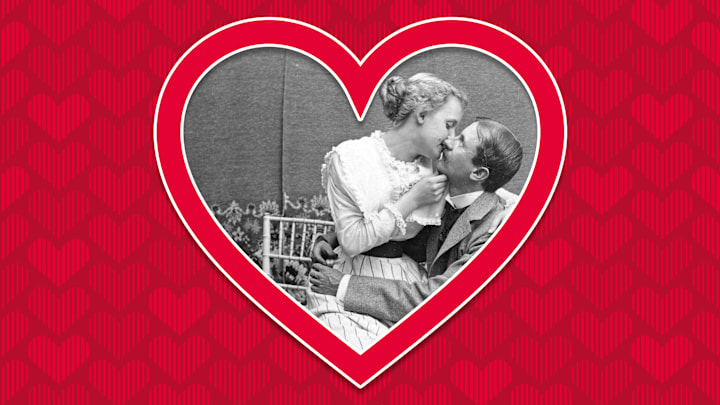Valentine’s Day is the opportune holiday to express all the lovey-dovey feelings you may not usually take the time to put into words—simply calling your partner “pretty” on the most romantic day of the year, however, might not exactly make the sparks fly. To help you get creative, here are some old-fashioned romance terms from days of yore that you might want to slip into conversation this Valentine’s Day. (And feel free to use these love-related terms from around the world, too.)
1. Bughouse
Decades before Beyoncé created a chart-topping melody to describe the feeling of being “crazy in love,” early 20th-century Americans simply called it “bughouse.”
2. and 3. Buss and Smouch

Buss is an old-fashioned synonym of kiss that originated around 1570, possibly from the Middle English verb bassen, meaning “to kiss.” It also sounds fairly similar to a few kiss terms from Romance languages, like the French baiser, the Spanish beso, and Italian’s bacio. Smouch—which may have come from the German term schmutz—is a word for a kiss that emerged not long after buss. “Come smack me, I long for a smouch,” George Whetstone wrote in 1578’s The Right Excellent Historye of Promos and Cassandra, the OED’s earliest citation for the word. Smooch would eventually derive from smouch.
4. Dainty Duck
In Shakespeare’s A Midsummer Night’s Dream, Pyramus refers to his lover, Thisbe, as a “dainty duck.” They didn’t exactly live happily ever after, but that’s no reason not to bring back dainty duck as an adorable (and alliterative) term of endearment.
5. Dimber

From stunning to hunky, there are plenty of satisfactory ways to call someone “attractive.” None, however, have quite as much old-timey appeal as dimber, a gender-neutral term for pretty from the 17th century. Dimber cove refers to a handsome man, while dimber mort is used for a pretty girl or woman.
6. Dulcinea
In Miguel de Cervantes’s Don Quixote, the titular character nicknames a lovely peasant girl “Dulcinea,” derived from dulce, the Spanish word for sweet. Over time, people started using it as a general term for sweetheart.
7. Endaunt
Endaunt first entered the lexicon in 1393 as a verb meaning “to tame,” and within a few years gained a new sense: “to caress.”
8. Face Made of a Fiddle

If you find your partner irresistibly charming, you can tell them that they have a “face made of a fiddle”—a face so welcoming and attractive that it seems to mirror the smile-like curves of a fiddle. Just be careful not to confuse it with having a “face as long as a fiddle,” which describes a dismal, unhappy demeanor.
9. Fairhead
This old-fashioned compliment—which might date all the way back to the 1200s—can be used for anyone who is beautiful or attractive.
10. Hunky-Peroodlum
If you’re feeling a little saucy, use hunky-peroodlum this Valentine’s Day. It’s an adjective from the early 1900s for someone who is attractive and inviting in the sexual sense. It was preceded by the term hunky dory (which dates to the 1860s) and succeeded by hunky-dunky (from the 1950s).
11. Jam Tart

Because Valentine’s Day is filled with sweet treats already, it’s only fitting that you’d replace the word heart with jam tart—a classic bit of Cockney rhyming slang for your ticker.
12. and 13. Nug and Pug
Nug is a term of endearment dates back to 1699. Its etymology is unknown, but it may be related to the word pug, an older term of endearment for a person, pet, or thing from 1580.
14. Prigster
If you’re fighting for the heart of a fair maiden, you can call your competitor a “prigster,” a word dating back to the 1670s that means “a rival in love.”
15. Pulchritudinous
It might not sound like it, but pulchritudinous is actually a compliment—it’s a term from the 1870s meaning “beautiful, attractive,” usually in reference to a woman.
16. RILY

Lovers were expressing their feelings in shorthand long before the invention of texting—starting in the mid-1940s, telegrams sometimes contained the acronym RILY, for “Remember, I love you.”
17. Smooge/Smooging
This Valentine’s Day, tell your partner you want to do some smooge/smooding, early 20th-century slang from Australia and New Zealand for engaging in “affectionate or amorous behavior,” per the OED.
Read More Articles About Old and Unusual Words:
18. Spoon
Engaging in a little foolish flirtation this Valentine’s Day? Your 19th-century ancestors might call that “spooning.”
19. Sugar Report
Sugar report caught on during World War II as a slang term for the letters that soldiers received from their wives and girlfriends back home. If you’re sending a lengthy email to your partner detailing your romantic itinerary for Valentine’s Day, feel free to type Sugar Report as the subject line.
20. Zippy

Zippy is a term for “an exceptional, attractive person” that dates back to 1915, according to Green’s; later, it also came to be used as an adjective meaning “fashionable.” Either way, it’s something your loved one will appreciate hearing any day of the year.
A version of this story ran in 2020; it has been updated for 2024.
